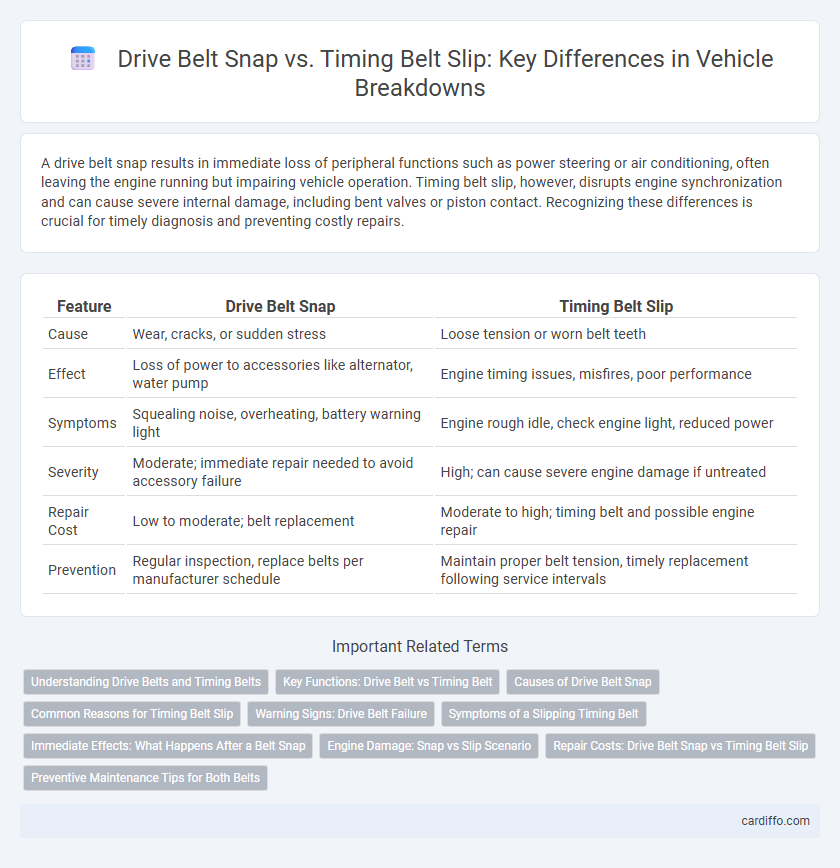A drive belt snap results in immediate loss of peripheral functions such as power steering or air conditioning, often leaving the engine running but impairing vehicle operation. Timing belt slip, however, disrupts engine synchronization and can cause severe internal damage, including bent valves or piston contact. Recognizing these differences is crucial for timely diagnosis and preventing costly repairs.
Table of Comparison
| Feature | Drive Belt Snap | Timing Belt Slip |
|---|---|---|
| Cause | Wear, cracks, or sudden stress | Loose tension or worn belt teeth |
| Effect | Loss of power to accessories like alternator, water pump | Engine timing issues, misfires, poor performance |
| Symptoms | Squealing noise, overheating, battery warning light | Engine rough idle, check engine light, reduced power |
| Severity | Moderate; immediate repair needed to avoid accessory failure | High; can cause severe engine damage if untreated |
| Repair Cost | Low to moderate; belt replacement | Moderate to high; timing belt and possible engine repair |
| Prevention | Regular inspection, replace belts per manufacturer schedule | Maintain proper belt tension, timely replacement following service intervals |
Understanding Drive Belts and Timing Belts
Drive belts transfer power to vehicle accessories like the alternator and air conditioning, while timing belts synchronize engine camshaft and crankshaft rotations for precise valve timing. A drive belt snap causes accessory failure and engine overheating, whereas a timing belt slip disrupts engine timing, potentially causing severe internal damage. Understanding these functions helps diagnose breakdowns accurately and prioritize timely maintenance to prevent costly repairs.
Key Functions: Drive Belt vs Timing Belt
The drive belt powers essential accessories such as the alternator, power steering pump, and air conditioning compressor, ensuring smooth operation of various vehicle functions. In contrast, the timing belt synchronizes the crankshaft and camshaft rotations, maintaining precise engine valve timing crucial for combustion efficiency. Failure of the drive belt typically leads to accessory malfunctions, while timing belt slip can cause severe engine damage due to misaligned valve timing.
Causes of Drive Belt Snap
Drive belt snap typically occurs due to excessive tension, wear and tear, or exposure to oil and heat that weaken the belt's rubber material. A snapped drive belt often results from misalignment of pulleys or damaged components causing abnormal stress. Regular inspection for cracks, fraying, and proper tension adjustment helps prevent sudden drive belt failure.
Common Reasons for Timing Belt Slip
Timing belt slip commonly occurs due to worn tensioners, insufficient belt tension, or oil contamination, which reduces the belt's grip on the pulleys. Unlike a drive belt snap that results from physical breakage, timing belt slip can cause engine misalignment, leading to poor performance and potential engine damage. Regular maintenance and timely replacement of worn components prevent timing belt slip and ensure proper engine timing.
Warning Signs: Drive Belt Failure
Warning signs of drive belt failure include squealing noises from the engine, visible cracks or fraying on the belt surface, and loss of power steering or alternator function. A snapping drive belt results in immediate accessory failure and engine overheating risk, whereas timing belt slip causes engine misfires and poor performance. Regular inspection and replacement based on manufacturer intervals prevent sudden breakdowns related to belt issues.
Symptoms of a Slipping Timing Belt
A slipping timing belt often causes irregular engine performance, including misfires, rough idling, and a noticeable loss of power, as the engine's camshaft and crankshaft become unsynchronized. Unusual noises such as ticking or slapping sounds from the timing belt cover area can also indicate a slipping belt. Unlike a drive belt snap that results in immediate accessory failure, timing belt slippage gradually deteriorates engine timing, leading to potential severe engine damage if not addressed promptly.
Immediate Effects: What Happens After a Belt Snap
A drive belt snap causes immediate loss of accessory functions like power steering, alternator, and air conditioning, leading to potential engine overheating and electrical failure. In contrast, a timing belt slip disrupts engine timing, often resulting in misfires, poor performance, or severe engine damage due to valve-piston collisions. Both issues require urgent attention to prevent extensive mechanical damage and costly repairs.
Engine Damage: Snap vs Slip Scenario
A drive belt snap typically causes a sudden loss of accessory functions such as the alternator or power steering, rarely leading to major engine damage. In contrast, a timing belt slip can result in valves and pistons colliding, causing severe internal engine damage and costly repairs. Prompt inspection and replacement of a worn timing belt are crucial to prevent catastrophic engine failure.
Repair Costs: Drive Belt Snap vs Timing Belt Slip
Repair costs for a drive belt snap typically range from $100 to $300, reflecting the simpler replacement process and less labor involved. Timing belt slip repair is significantly more expensive, often costing between $500 and $1,000 due to the complexity of accessing and aligning engine components. Misalignment from timing belt slip can cause engine damage, increasing repair expenses beyond typical replacement costs.
Preventive Maintenance Tips for Both Belts
Drive belt snap and timing belt slip both cause engine malfunctions, demanding precise preventive maintenance to avoid costly repairs. Regular inspection for cracks, fraying, or wear on the drive belt coupled with timely replacement every 60,000 to 100,000 miles ensures optimal function. For the timing belt, adherence to manufacturer-recommended replacement intervals, often between 60,000 and 90,000 miles, and checking for signs of slippage like engine misfires or unusual noises significantly reduces breakdown risks.
Drive belt snap vs timing belt slip Infographic

 cardiffo.com
cardiffo.com